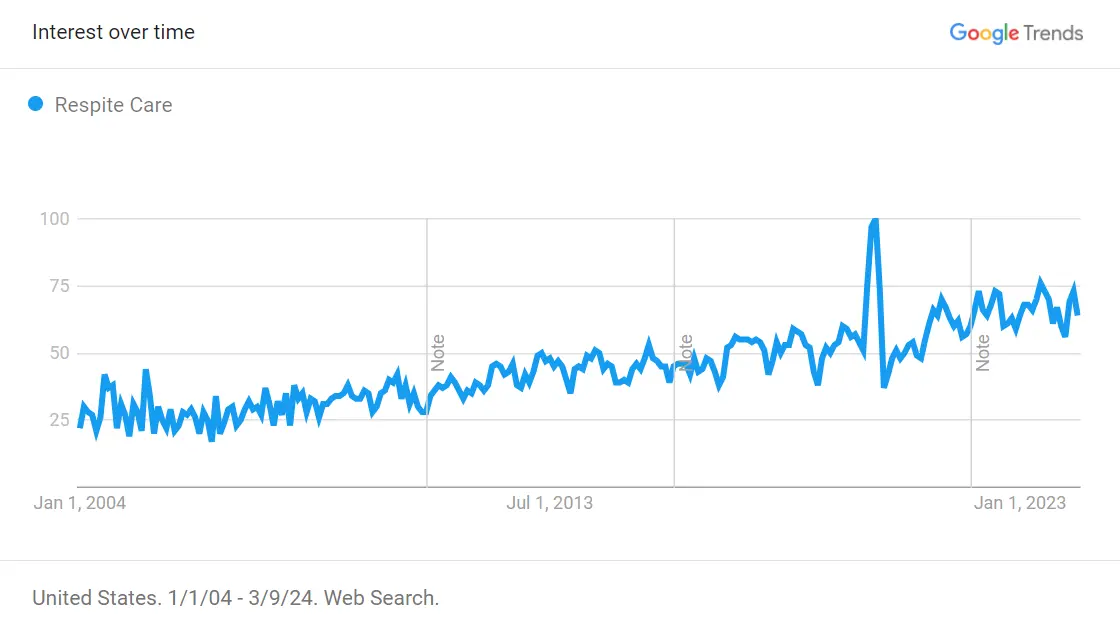Starting a respite care business for individuals with special needs is not just a noble pursuit but also a growing need in communities across the globe.
With the increasing recognition of the essential support respite care provides to families, this business area offers significant opportunities for entrepreneurs who are passionate about making a difference.
We’ll explore everything from becoming a certified respite care provider to understanding respite care provider qualifications in California, and even how to become a respite care provider in Ohio, ensuring you have the information needed to embark on this rewarding journey.
Our Verdict
- Research state-specific requirements.
- Complete required training and certification.
- Undergo background checks.
- Stay informed about medicaid policies.
- Consider creative service models: Think beyond traditional in-home or facility-based care. Offer virtual respite care through video calls for social interaction and support, or partner with schools to provide after-school respite programs.
- Explore grant opportunities: Research government grants or funding programs dedicated to supporting respite care services, particularly for underserved communities.
- Ignore local regulations.
- Skip continuing education.
- Underestimate the importance of insurance.
- Forget about self-care for caregivers: Respite care providers often experience compassion fatigue. Offer support groups, training on stress management, and competitive benefits to retain qualified staff.
- Overlook sibling support: Many families with special needs children also have neurotypical siblings who can feel neglected. Offer sibling support groups or respite packages that include activities for both children.
Learn About Medicaid
Medicaid is a joint federal and state program that provides health coverage to low-income adults, children, pregnant women, elderly adults, and people with disabilities in the United States.
Eligibility is primarily based on income, with each state setting its own guidelines within federal standards.
Medicaid covers a wide range of services, including mandatory benefits like hospital services and optional benefits that states may choose to provide, such as prescription drugs and dental services.
The program is funded by both the federal government and states, with the federal share determined by the Federal Medical Assistance Percentage (FMAP) based on state income levels.
Medicaid plays a crucial role in the American healthcare system, significantly reducing uninsured rates and improving access to healthcare for vulnerable populations.
Calculate your business expenses here:
Budget Calculator
Required Equipment and Average Cost
Starting a respite care business for individuals with special needs requires a range of equipment to ensure safe, effective, and comfortable care.
Basic Office Setup
- Office Furniture
- Desk: $100 – $500
- Chairs: $50 – $300 each
- Filing Cabinets: $100 – $300
- Reception Desk: $200 – $1,000
- Waiting Room Furniture: $200 – $1,000
- Office Supplies
- Computers/Laptops: $500 – $1,500 each
- Printer/Scanner: $100 – $300
- Telephones: $50 – $200 each
- Internet Router: $50 – $200
- Stationery (pens, paper, files, etc.): $50 – $200
Care Equipment
- Medical Equipment
- First Aid Kits: $20 – $100 each
- Blood Pressure Monitors: $20 – $100
- Thermometers: $10 – $50
- Glucometers (if needed): $20 – $50
- Pulse Oximeters: $20 – $50
- Mobility Aids
- Wheelchairs: $150 – $500 each
- Walkers: $30 – $100 each
- Canes: $10 – $50 each
- Lifting and Transferring Aids
- Hoyer Lifts: $500 – $1,500
- Transfer Boards: $30 – $100
- Gait Belts: $10 – $30 each
Safety and Accessibility
- Safety Equipment
- Grab Bars: $10 – $50 each
- Non-Slip Mats: $10 – $30 each
- Bed Rails: $50 – $200
- Communication Aids
- Picture Communication Symbols: $20 – $50 per set
- Tablets with Communication Apps: $200 – $500 each
Comfort and Daily Living
- Beds and Bedding
- Hospital Beds: $500 – $2,000 each
- Pressure-Relief Mattresses: $100 – $500
- Waterproof Mattress Covers: $20 – $50 each
- Daily Living Aids
- Adaptive Eating Utensils: $10 – $30 per set
- Bathing Aids (bath chairs, etc.): $30 – $200
- Dressing Aids (button hooks, etc.): $5 – $20 each
Recreational and Therapeutic Equipment
- Recreational Equipment
- Sensory Toys: $10 – $50 each
- Adaptive Games: $10 – $50 each
- Art Supplies: $20 – $100
- Therapeutic Equipment
- Therapy Balls: $10 – $50 each
- Weighted Blankets: $50 – $100
- Therapy Swings: $100 – $500
Transportation
- Transportation
- Accessible Van: $30,000 – $50,000 (new) or $10,000 – $30,000 (used)
- Car Seats and Safety Harnesses: $50 – $200 each
Miscellaneous
- Insurance and Licensing
- Business Insurance: $500 – $2,000 annually
- Licenses and Permits: $100 – $500 depending on local regulations
Staff-Related Costs
- Uniforms
- Uniforms/Scrubs: $20 – $50 each set
- Name Badges: $5 – $20 each
Total Initial Costs
For a small to medium-sized operation, expect to budget between $20,000 and $50,000, excluding the cost of an accessible van, which can significantly increase initial costs.
This comprehensive list covers the essential equipment and average costs needed to start a respite care business for special needs individuals. Adjustments may be needed based on specific care requirements, local regulations, and business scale.
Before you form a new company, you should understand the ins and outs of what you’re stepping into.
Respite care provides temporary relief to primary caregivers, offering them a much-needed break while ensuring that their loved ones continue to receive professional and compassionate care.
This service is invaluable for families of individuals with special needs, where the demands of care can be intensive and constant.
Respite care is a vital service designed to provide temporary relief to family members or primary caregivers who are responsible for the continual care of individuals with disabilities, chronic illnesses, or the elderly.
This form of care is essential in preventing caregiver burnout, a common issue due to the physical, emotional, and financial strain associated with long-term caregiving responsibilities.
Respite care offers a compassionate solution that benefits both caregivers and the individuals they support, ensuring that the latter continue to receive professional, high-quality care in the absence of their primary caregivers.
Respite care can be offered in various settings and formats, depending on the needs of the individual and their family. Common types include:
- In-home respite care: Caregivers come to the home to provide services, allowing the individual to remain in a familiar environment. This type can range from a few hours to overnight stays.
- Adult day centers: These facilities offer care and social activities during the day, providing a safe environment for adults who cannot be left alone.
- Residential respite care: Short-term stays in facilities like nursing homes or assisted living communities for individuals who need round-the-clock care.
- Specialized respite care: Tailored services for individuals with specific conditions, such as Alzheimer’s disease or other forms of dementia.
The advantages of respite care extend to both the caregivers and the recipients of care:
- Prevents Caregiver Burnout: By offering a temporary break, respite care helps prevent the physical and emotional exhaustion caregivers often face.
- Promotes Well-being: Caregivers can use the time off to rest, attend to personal matters, or enjoy leisure activities, contributing to their overall well-being.
- Enhances Quality of Care: Periodic breaks can enable caregivers to return to their duties with renewed energy and patience, ultimately enhancing the quality of care provided to the individual.
- Socialization Opportunities: For the recipients of care, especially in group settings like adult day centers, respite care offers valuable social interaction and engagement in activities that can enhance their quality of life.
Eligibility for respite care services often depends on the specific circumstances of the caregiver and the needs of the individual requiring care.
Generally, families or caregivers who are responsible for the continuous care of individuals with significant health issues or disabilities may qualify for respite services.
Funding sources for respite care, such as private pay, insurance, or government programs like Medicaid, may have their own eligibility criteria.
2. The Demand for Quality Respite Care
The need for quality respite care cannot be overstated. It serves a critical role in maintaining the health and well-being of both caregivers and their loved ones.
Regions such as Syracuse, NY, have seen a growing demand for these services, reflecting a broader national trend.
Whether funded privately or through programs like Medicaid, which often covers respite care services, the demand for skilled providers continues to rise.
Industry Size and Growth
The respite care industry is a segment of the broader healthcare and long-term care market. Its growth has been propelled by the aging population, increased recognition of caregiver burnout, and the rising prevalence of chronic diseases and disabilities that require continuous care.
Growth Rate: The market for respite care services has been experiencing steady growth, with projections suggesting continued expansion due to the aging baby boomer population. According to the U.S. Census Bureau, by 2030, all baby boomers will be older than 65, increasing the demand for elderly care services, including respite care.
Market Value: While specific numbers can fluctuate based on geographic location and service offerings, the global home healthcare market, which includes respite care, was valued at approximately $281.8 billion in 2019 and is expected to reach around $354.3 billion by 2026, growing at a CAGR of around 3.6% during the forecast period.

Demographic Trends
Aging Population: The primary driver of demand for respite care services is the growing elderly population. With people living longer, there is a higher prevalence of age-related conditions such as dementia, necessitating specialized care.
Family Dynamics: Changing family structures and increasing female workforce participation reduce the availability of family caregivers, leading more families to seek professional respite care services.
Competition and Market Segmentation
Local and National Providers: The market includes a mix of local independent providers and national chains, offering varied services from in-home care to facility-based care. Competitive differentiation is often based on service quality, specialization (e.g., dementia care), and pricing.
Specialized Services: There’s a growing trend towards specialized respite care services catering to specific conditions, such as Alzheimer’s or autism, providing tailored care plans and activities.
Regulatory Considerations
State Regulations: Respite care providers must navigate a complex landscape of state-specific regulations, including licensing requirements, staff qualifications, and safety standards.
Funding and Insurance: Understanding how services are funded (private pay, insurance, Medicaid) is crucial. Policies regarding coverage can influence demand and access to respite care services.
Challenges and Opportunities
Workforce Shortages: Like many sectors in healthcare, respite care faces challenges in recruiting and retaining qualified staff, exacerbated by the pandemic.
Technology Integration: There’s an opportunity to leverage technology to improve service delivery, from scheduling platforms for families to telehealth services that complement traditional care.
Future Trends
Increased Demand for In-Home Care: The preference for aging in place supports the growth of in-home respite services.
Policy and Funding Shifts: Potential changes in healthcare policy and funding, especially regarding long-term care insurance and Medicaid, could impact the market dynamics for respite care.
Conduct Market Research
Before starting your respite care business, conduct thorough market research to understand the specific needs of your community. Identify the existing services, such as those in Syracuse, NY, and pinpoint gaps you can fill.
Understanding who pays for respite care and how they do so (private pay, insurance, or Medicaid) will also help in shaping your business model.
3. Obtain Necessary Certifications and Qualifications
Becoming a certified respite care provider is crucial. The qualifications required can vary by state.
For instance, the respite care provider qualifications in California may differ from those in Ohio.
Generally, this process involves undergoing training that covers the basics of respite care, emergency procedures, and the specific needs of individuals with disabilities.
Gaining respite care certification not only bolsters your credibility but also ensures you meet state regulations.
1. Business License
Description: A basic requirement for any business, including respite care services. It grants the permission to operate in your city or county.
Where to Obtain: Local city or county clerk’s office.
2. Health Care License
Description: Required for businesses providing any form of medical care, which may include respite care services, especially if they involve any medical procedures or administration of medications.
Where to Obtain: State health department or relevant regulatory body overseeing health care services in your state.
3. Home Care License (if providing in-home services)
Description: Necessary for businesses providing non-medical care and support services in the client’s home. Requirements can vary widely by state.
Where to Obtain: State department of health or a specific board that regulates home care services.
4. Zoning Permits
Description: If you are operating a facility-based respite care service, you need to ensure your operation complies with local zoning laws.
Where to Obtain: Local zoning office or city planning department.
5. Specialty Licenses
Description: Depending on the nature of the respite care services (e.g., caring for individuals with specific disabilities or medical conditions), additional specialty licenses may be required.
Where to Obtain: State or federal regulatory bodies that oversee services for specific populations or conditions.
6. Employer Identification Number (EIN)
Description: Necessary for hiring employees, opening a business bank account, and for tax purposes.
Where to Obtain: You can easily get your federal employer identification number by ordering online.
7. Background Check Clearances
Description: Required for all staff and sometimes for the owners as well, especially if working with vulnerable populations like children or the elderly.
Where to Obtain: State or local law enforcement agencies, or third-party background check services.
8. Occupational Safety and Health Administration (OSHA) Compliance
Description: Ensures that your business complies with federal and state safety and health regulations.
Where to Obtain: Complete necessary training and certifications through OSHA-approved providers.
Steps to Obtain Necessary Licenses and Permits:
- Research Specific Requirements: Begin by researching the specific requirements in your state and locality. This might involve visiting official websites and contacting regulatory bodies directly.
- Complete Necessary Training: Some licenses, especially those related to health care, may require completing specific training programs or certifications.
- Submit Applications: Prepare and submit applications for the required licenses and permits. Be prepared to pay any associated fees.
- Pass Inspections: If your business operates out of a physical location, you may need to pass health, safety, and zoning inspections.
- Maintain Compliance: Ensure ongoing compliance with all regulatory requirements, including renewing licenses and permits as needed.
Starting a respite care business involves navigating a complex landscape of regulatory requirements.
Careful attention to obtaining and maintaining the correct licenses and permits is essential for operating legally and successfully.
Engaging with legal professionals or consultants who specialize in healthcare services can provide valuable guidance through this process.
4. Develop Your Business Plan
Your business plan should detail your service offerings, operational model, marketing strategies, and financial projections. It should also outline how you intend to become a respite provider, including steps for recruitment, training, and retaining skilled respite care workers.
Detailing the respite care job description and duties within your plan will help in attracting the right talent.
Choosing a business structure is one of the first and most important steps. To ensure proper procedure, consider hiring a business formation service.
Sole Proprietorship
A sole proprietorship is the simplest business form, where the business is owned and run by one person. There’s no distinction between the owner and the business for legal or tax purposes.
Pros: Easy and inexpensive to set up, complete control by the owner, and straightforward tax reporting.
Cons: The owner is personally liable for all business debts and liabilities, which can be particularly risky in the healthcare sector due to the potential for lawsuits.
Partnership
A partnership is a business owned by two or more people. Like sole proprietorships, partnerships offer no personal liability protection to the owners.
Pros: Easy to establish, more capital available with multiple owners, and benefits from combined skills and resources.
Cons: Partners are personally liable for business debts and liabilities, and there can be conflicts between partners.
Corporation (C Corp or S Corp)
A corporation is a legal entity separate from its owners, providing the highest level of personal liability protection. Corporations can be taxed as either C Corps or S Corps.
Pros: Limited liability for owners, ability to raise capital through the sale of stock, and perpetual existence.
Cons: More complex and expensive to set up and operate, subject to double taxation (C Corp), and more regulatory requirements.
Limited Liability Company (LLC)
An LLC combines the liability protection of a corporation with the tax benefits and operational flexibility of a partnership or sole proprietorship. It’s a popular choice for small to medium-sized businesses.
Pros for a Respite Care Business:
- Limited Liability: Owners (members) are protected from personal liability for business debts and lawsuits, which is crucial in the healthcare sector.
- Tax Flexibility: LLCs can choose to be taxed as a sole proprietorship, partnership, or corporation, offering flexibility to optimize tax obligations.
- Operational Flexibility: LLCs are not subject to the strict operational requirements of corporations, allowing for easier management and administration.
- Credibility: Forming an LLC can enhance the credibility of the business with potential clients and partners.
Why LLC is Often the Best Choice
For most respite care businesses, an LLC offers an attractive blend of liability protection, tax advantages, and operational simplicity. The healthcare industry faces inherent risks, including legal claims and financial liabilities.
The LLC structure protects owners’ personal assets from business-related lawsuits, making it an excellent choice for those providing care services.
Additionally, the flexibility in tax treatment allows owners to choose the most advantageous taxation method for their specific situation.
For example, being taxed as an S Corp can be beneficial for businesses that generate significant income, allowing owners to save on self-employment taxes.
Finally, the credibility and professionalism associated with the LLC designation can help in establishing trust with clients, employees, and partners. It signals that the business is a serious, committed entity within the healthcare industry.
5. Secure Funding and Insurance
Understanding the financial aspects, including who pays for respite care and how does respite care work, is vital.
You may need to secure funding through loans or investors. Additionally, obtaining the appropriate insurance coverage is non-negotiable to protect your business and the individuals you serve.
Initial Funding Requirements
Starting a respite care business requires capital for various startup costs, including:
- Licenses and Permits: Costs associated with obtaining the necessary licenses and permits to operate legally.
- Facility Costs: If operating a facility-based service, expenses include leasing or purchasing property, renovation, and compliance with accessibility standards. An alternative is to get virtual office services.
- Equipment and Supplies: Medical and non-medical supplies, office equipment, and any specialized equipment needed for care.
- Technology: Investment in software for scheduling, billing, client management, and possibly a website.
- Insurance: Liability insurance, workers’ compensation, and any other relevant insurance coverage.
- Marketing and Advertising: Initial marketing efforts to establish brand presence and attract clients.
- Training and Background Checks: Costs associated with training staff and conducting background checks.
Ongoing Operational Expenses
- Salaries and Wages: Compensation for staff, including benefits if offered.
- Facility Maintenance: Ongoing costs for maintaining any physical location.
- Utilities: Electricity, water, internet, and other utility expenses.
- Supplies and Equipment: Regular replenishment of supplies and maintenance or replacement of equipment.
- Insurance Premiums: Regular payments for maintaining insurance coverage.
- Marketing and Advertising: Continuous efforts to promote the business and attract new clients.
Budget Estimate
While the initial investment and operational costs can vary widely based on the scale of the business and location, below is a rough estimate for starting a small to medium-sized respite care business:
Initial Startup Costs: $50,000 to $100,000. This range can vary significantly depending on whether you’re starting an in-home service (lower end) or a facility-based service (higher end).
Monthly Operating Expenses: $20,000 to $50,000. This estimate includes salaries for a small team, facility rent (if applicable), utilities, supplies, insurance, and marketing.
For a better result, calculate your business expenses here:
Budget Calculator
Securing Funding
- Personal Savings: Many entrepreneurs start with their own savings, though this may not cover all costs.
- Loans: Business loans from banks or financial institutions are a common source of funding. SBA loans in the United States might offer favorable terms.
- Investors: Angel investors or venture capitalists interested in healthcare opportunities.
- Grants: Some government and private grants are available for healthcare services, especially those serving underrepresented or special needs communities.
Financial Planning Tips
- Create a Detailed Business Plan: Include a comprehensive financial section outlining your initial and ongoing costs, revenue projections, and profitability timeline.
- Monitor Cash Flow: Regularly review your business’s cash flow to manage finances effectively and ensure you can cover operating expenses.
- Set Aside a Contingency Fund: Unexpected costs can arise, so having a reserve fund can help your business navigate through unforeseen financial challenges.
- Reinvest Profits: In the early stages, consider reinvesting profits to grow the business, expand services, or improve facilities.
- Create a Detailed Business Plan: Include a comprehensive financial section outlining your initial and ongoing costs, revenue projections, and profitability timeline.
6. Market Your Services
Effective marketing strategies are essential to attract clients. Highlight how your services meet the needed respite care in your area.
Utilize digital marketing tactics, focusing on SEO strategies using keywords such as “respite care Syracuse NY” or “how to qualify for respite care,” to improve your online visibility.
Networking with local healthcare providers, schools, and community centers can also help in promoting your services.
1. Develop a Strong Online Presence
Website: Create a professional website that is easy to navigate and provides comprehensive information about your services, staff qualifications, and contact information. Include testimonials from families you’ve worked with to build trust.
SEO: Optimize your website for search engines to ensure it appears in search results when potential clients are looking for respite care services in their area. Use relevant keywords like “respite care [Your City]” or “special needs care services.”
2. Utilize Social Media
Engagement: Use platforms like Facebook, Instagram, and LinkedIn to engage with your community. Share helpful content, stories, and updates about your services to keep your audience informed and engaged.
Targeted Ads: Social media platforms offer targeted advertising options that allow you to reach specific demographics, such as families of individuals with special needs in your local area.
3. Content Marketing
Blog Posts: Write informative blog posts about respite care, tips for caregivers, and other relevant topics. This not only helps in SEO but also establishes your business as a knowledgeable and helpful resource.
Videos: Create video content that highlights your services, shares family testimonials, or provides virtual tours of your facility if you have one.
4. Community Engagement and Networking
Partnerships: Build relationships with local healthcare providers, hospitals, and support groups for individuals with special needs. They can refer families to your service.
Community Events: Participate in or sponsor local events related to caregiving and special needs. It’s a great way to raise awareness of your business and demonstrate your commitment to the community.
5. Offer Workshops and Support Groups
Educational Workshops: Host free workshops for caregivers on topics such as stress management, navigating healthcare services, and advocacy for individuals with special needs.
Support Groups: Offer space and facilitation for support groups. This can position your business as a community hub for caregivers and families of individuals with special needs.
6. Becoming an Independent Provider
For those interested in how to become an independent provider, the process involves similar steps but with a focus on individualized service.
This route offers the flexibility to tailor your services to the specific needs of families and their loved ones, potentially filling a niche market within your community.
FAQs
1. How do I start as a respite care provider?
Begin by researching your state’s specific requirements, which may include obtaining licenses, undergoing training, and passing background checks mandated for health care providers.
2. What kind of training is required?
Training typically covers first aid, CPR, emergency response, and specialized care for individuals with disabilities. States may have unique training programs for respite care providers.
3. Are background checks necessary?
Yes, comprehensive background checks are generally required across states to ensure the safety and well-being of care recipients.
4. Do I need to be certified?
Certification requirements vary by state and sometimes by the type of care provided. Check with your state’s health or developmental disabilities department for specific guidelines.
5. How can I offer my services?
Options include registering as an independent provider with local health departments or joining an existing respite care agency that aligns with your qualifications and interests.
6. Is being a Medicaid provider required?
If you plan to serve clients on Medicaid, becoming a Medicaid-certified provider may be necessary. This involves additional standards and paperwork but allows you to serve a broader client base.




